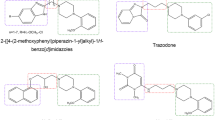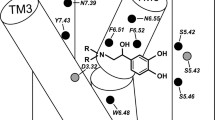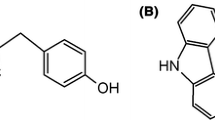Abstract
The non-selective classification refers to those beta-blockers capable of blocking both β1 and β2 receptors with equivalent efficacy. All of these beta-blockers consist of an aryloxypropanolamine side chain linked to an aromatic or heteroaromatic ring. Each of these drugs possesses at least one chiral center, and high degree of enantioselectivity in binding to beta-adrenergic receptor. In this research, ab initio method with 6-31G* basis set was employed for investigation of correlation between optimized geometry and biologically active configuration on both enantiomers of Timolol, Nadolol, Bunolol, and Propranolol. These calculations show higher stabilities for (S)-enantiomer compared with (R)-antipode, for each stereoisomer. Also, torsion angles around the N2C3C4O5 bond confirm that (S)- and (R)-Propranolol have the lowest and highest dihedral angles related to other non-selective beta-blockers, respectively. Furthermore, the (S)-enantiomers of beta-blockers reveal the more negative natural charges for oxygen atom in hydroxyl as well as nitrogen atom in aryloxypropanolamine group than related (R)-enantiomer.


Similar content being viewed by others
References
Ammon HL, Howe DB, Erhardt D et al (1977) The crystal structures of diehlorolsoproterenol, propranolol and propranolol hydroehloride. Acta Cryst B 33:21–29
Arshadi S, Bekhradnia AR, Ahmadi S et al (2011) New insights on the mechanism of thermal cleavage of unsaturated bicyclic diaziridines: a DFT study. Chin J Chem 29:1347–1352
Baker JG (2005) The selectivity of β-adrenoceptor antagonists at the human β1, β2 and β3 adrenoceptors. Brit J Pharmacol 144:317–322
Barrett A, Cullum V (1968) The biological properties of the optical isomers of propranolol and their effects on cardiac arrhythmias. Br J Pharmacol 34:43–55
Bekhradnia AR, Arshadi S (2007) Conformational analysis, infrared, and fluorescence Spectra of 1-Phenyl-1,2-propandione 1-oxime and related tautomers: experimental and theoretical study. Monatsh Chem 138:725–734
Bekhradnia AR, Arshadi S (2011) Theoretical study of halogen effect in isomerization of 2-halo-[9]-annulen anion at DFT level. Chin J Struc Chem 30:906–912
Bekhradnia AR, Ebrahimzadeh MA, Hejazi V, Gorji R (2009) New insight to hair-loss as a side effect of some drugs. Asian J Chem 3:2110–2118
GAUSSIAN 98, Revision A. 6, Frisch M, Trucks G, Schlegel H, Scuseria G, Robb M, Cheeseman J, Znkrzewski V, et al., (1998) Gaussian Inc., Pittsburgh PA
Horinouchi T, Morishima S, Tanaka Y, Koike K, Miwa S, Muramatsu I (2009) Pharmacological evaluation of ocular β-adrenoceptors in rabbit by tissue segment binding method. Life Sci 84:181–187
Jeppsson AB, Johansson U, Waldeck B (1984) Steric aspects of agonism and antagonism at beta-adrenoceptors: experiments with the enantiomers of terbutaline and pindolol. Acta Pharmacol Toxicol 54:285–291
Kadam RS, Kompella UB (2009) Cassette analysis of eight beta-blockers in bovine eye sclera, choroid–RPE, retina, and vitreous by liquid chromatography–tandem mass spectrometry. J Chromatogr B 877:253–260
Kassaee MZ, Bekhradnia AR, Arshadi S (2008) Reaction of aspirin with Fecapentaene-12: a possibility for aspirin to make Fecapentaene-12 lose its mutagenecity. Asian J Chem 1:43–47
Mehvar R, Brocks DR (2001) Stereospecific pharmacokinetics and pharmacodynamics of beta-adrenergic blockers in humans. J Pharm Pharmaceut Sci 4:185–200
Nathanson JA (1988) Stereospecificity of beta adrenergic antagonists: R-enantiomers show increased selectivity for beta-2 receptors in ciliary process. J Pharmacol Exp Ther 245:94–101
Pearson AA, Gaffney TE, Walle T, Privitera PJ (1989) A stereoselective central hypotensive action of atenolol. J Pharmacol Exp Ther 250:759–763
Rouvinen J, Pohjala E, Vepsalainen J, Malkonen P (1990) Drug Design Delivery 5:281
Sadlej-Sosnowska N, Dobrowolski JCZ, Mazurek AP (2000) On the conformation of the propranolol molecule. J Mol Struc 520:165–171
Smith C, Teitler M (1999) Beta-blocker selectivity at cloned human beta1- and beta2-adrenergic receptors cardiovasc. Drug Ther 13:123–126
Stoschitzky K, Egginger G, Zernig G, Klein W, Lindner W (1993) Stereoselective features of (R)- and (S)-atenolol: clinical pharmacological, pharmacokinetic and radioligand binding studies. Chirality 5:15–19
Topiol S, Sabio M (2008) Use of the X-ray structure of the Beta2-adrenergic receptor for drug discovery. Bioorg Med Chem Lett 18:1598–1602
Acknowledgments
This research was partially supported by a grant from Pharmaceutical Research Network, Tehran, Iran and Pharmaceutical Sciences Research Center of Mazandaran University of Medical Sciences, Sari, Iran. The authors gratefully acknowledge the financial support of this study by the Mazandaran University of Medical Sciences ‘‘Professor’s projects funds’’ and “Pharmaceutical Research Network of Iran”.
Author information
Authors and Affiliations
Corresponding author
Rights and permissions
About this article
Cite this article
Bekhradnia, A.R., Ebrahimzadeh, M.A. Theoretical study on some non-selective beta-adrenergic antagonists and correlation to their biologically active configurations. Med Chem Res 21, 2571–2578 (2012). https://doi.org/10.1007/s00044-011-9781-3
Received:
Accepted:
Published:
Issue Date:
DOI: https://doi.org/10.1007/s00044-011-9781-3




